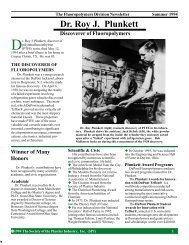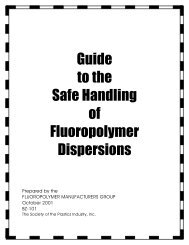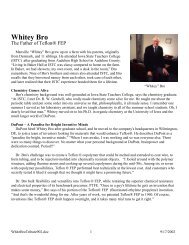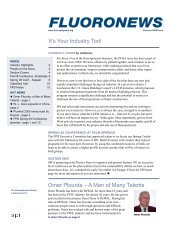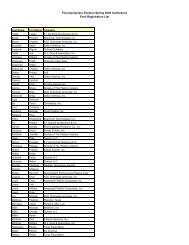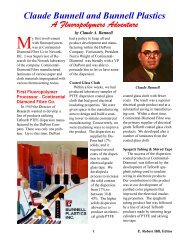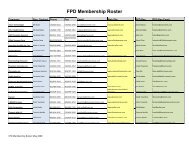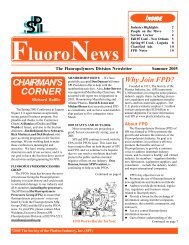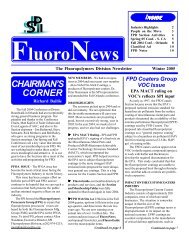FluoroGuide - Fluoropolymers Division
FluoroGuide - Fluoropolymers Division
FluoroGuide - Fluoropolymers Division
Create successful ePaper yourself
Turn your PDF publications into a flip-book with our unique Google optimized e-Paper software.
Why Use <strong>Fluoropolymers</strong>?<br />
Most of the useful properties of fluoropolymers are due to fluorine, the most electro-negative element<br />
and the most reactive non-metal. Its atomic radius is the smallest next to hydrogen, and it forms<br />
extremely strong bonds with other elements. When reacted with carbon in fluoropolymers, the<br />
extremely strong, tight bond produces an extraordinary combination of properties.<br />
Extraordinary Properties<br />
• Chemically inert • Nontoxic<br />
• Nonwetting • Nonstick<br />
• Low Coefficient of Friction • Highly fire resistant<br />
• Low dielectric constant • High temperature ratings<br />
Solving Problems and Reducing Cost<br />
This unrivalled combination of properties frequently makes fluoropolymers the product of choice when metals<br />
and less expensive plastics fail or where long term reliability is required. <strong>Fluoropolymers</strong> are often used to<br />
solve existing problems or to develop new technology. Despite a relatively high cost, fluoropolymers have<br />
frequently been used to substantially reduce overall system cost.<br />
In many cases, fluoropolymers provide solutions when nothing else works. For example:<br />
• Fluoropolymer insulated plenum wiring eliminates the need for expensive metal conduit.<br />
• Fluoropolymer insulated wire reduces weight in airplane wiring.<br />
• Fluoropolymer lined industrial equipment has substantially lengthened equipment life.<br />
Diverse Uses<br />
Fluoroproducts are used in virtually every manufacturing industry and in many service industries. They are<br />
woven into our way of life from PTFE coated frying pans and oil additives to fabric-covered sports stadiums,<br />
computer hook-up wire, aircraft wire, fire alarm wire, under-hood car wire, down-hole oil well wire, plus seals<br />
and bearings for valves, pumps, and other industrial equipment. New needs and applications are constantly<br />
being uncovered.<br />
©2009 The Society of the Plastics Industry, Inc. (SPI)<br />
Page 2






